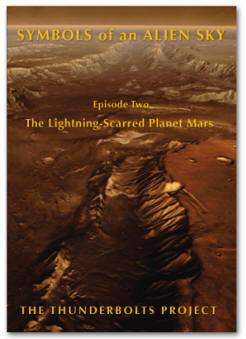|

Saturn's powerful "dragon storm" now
circles the planet. Credit:
NASA/JPL/Space Science Institute
The Dragon's Den
Aug
23, 2011
Saturn's electrically charged
atmosphere has erupted in
spectacular fashion.
Sungrazers are comets that pass
close to the Sun in their highly
elliptical orbits. They tend to
reaffirm the Electric Universe
opinion about comets: If comets are
the result of electrical events that
took place early in the life of the
Solar System, then their several
"anomalous" behaviors can be easily
explained.
Some comet anomalies include
Hale-Bopp's ion tail and coma when
it was far past Jupiter's orbit, the
catastrophic explosion of
Comet Linear when it was
over 100 million kilometers from the
Sun, the desert-like, cratered
appearance of Comets Borrelly and
Tempel 1 (contrary to the "dirty
snowball hypothesis), and
Shoemaker-Levy 9's broken pieces
refusing to expel any water vapor.
The Sun's radial e-field is a
dynamic structure, changing in
strength and size depending on the
corresponding strength of electric
currents that flow into it. For that
reason, it is in a state of constant
flux, requiring just a small trigger
for it to explosively discharge with
solar flares or coronal mass
ejections (CME).
Comet NEAT initiated a
CME eruption that appeared to impact
the comet.
Several other sungrazers
have been associated with violent
flares. When comet 96P/Machholz
circled the Sun its intense charge
differential caused a
gigantic CME to blast out
from the Sun for millions of
kilometers.The electrical connection
between comets and the Sun seems
certain. If that is the case, then
the electrical connection between
the Sun and its entire family of
planets and moons is certain.
Changes in electrical activity
affect the environments of every
member in that family.
Saturn could be thought of as a
solar system in its own right, with
a family of 31 moons. It possesses a
Langmuir charge sheath (plasmasphere)
that isolates it from the Sun's own
charge sheath that, in turn, is
isolating it from the charged
interstellar medium.
Many things about Saturn have
changed in the 31 years since the
two Voyager spacecraft passed by the
giant gas planet. Saturn's
magnetosphere grew by more than a
million kilometers and then
contracted, only to begin expanding
again. The spokes in Saturn's B ring
disappeared and then reappeared. The
equatorial thunderstorm (known as
the Dragon Storm) that raged
continuously broke up, moved toward
the poles, and then erupted again.
The most likely explanation for
the storms on Saturn is that they
are equivalent to sunspots. As the
Sun changes its behavior over the
course of a 22 year cycle, the
electrical output that connects it
with its family of planets varies.
If Saturn's Great White Spots,
Dragon Storm, and ring spokes are
driven by the same galactic
Birkeland currents that drive the
Sun, they should get stronger and
closer to the equator as the sunspot
cycle oscillates. It appears that
that is just what has happened over
the past three decades.
Every so often Saturn breaks out
with a
great white spot three
times larger than Earth. Traditional
models of Saturn cannot explain such
a periodic outburst, but an intense
lightning discharge deep in the
atmosphere could cause vertical jets
similar to the sprites in
Earth's upper atmosphere.
Its connection to the current
flow in the Solar System can explain
the effects that Cassini and other
science packages have discovered on
and around Saturn. Perhaps, like the
Sun, there are other factors that
link explosive discharges with
electrical connectivity.
Since Saturn's environment is
highly charged, could objects
traveling through its vicinity
initiate substantial electrical
events like sungrazers do? Presuming
Saturn to be a highly charged object
in a state of dynamic equilibrium,
could a Saturn-grazer start some of
the long-lasting lightning-like
disturbances there?
Stephen Smith
 New
DVD New
DVD
The Lightning-Scarred
Planet Mars
A video documentary that could
change everything you thought you
knew about ancient times and
symbols. In this second episode of
Symbols of an Alien Sky, David
Talbott takes the viewer on an
odyssey across the surface of Mars.
Exploring feature after feature of
the planet, he finds that only
electric arcs could produce the
observed patterns. The high
resolution images reveal massive
channels and gouges, great mounds,
and crater chains, none finding an
explanation in traditional geology,
but all matching the scars from
electric discharge experiments in
the laboratory. (Approximately 85
minutes)
Video Selections
Order Link
|





 New
DVD
New
DVD

